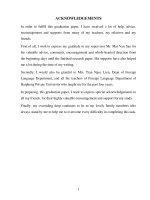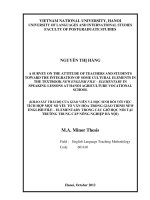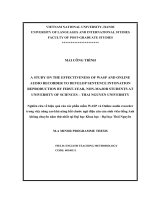A review on beneficial effects of PGPR and noble liquid manures in enhancing soil fertility and sustainability
Bạn đang xem bản rút gọn của tài liệu. Xem và tải ngay bản đầy đủ của tài liệu tại đây (148.67 KB, 7 trang )
Int.J.Curr.Microbiol.App.Sci (2019) 8(4): 409-415
International Journal of Current Microbiology and Applied Sciences
ISSN: 2319-7706 Volume 8 Number 04 (2019)
Journal homepage:
Review Article
/>
A Review on Beneficial Effects of PGPR and Noble Liquid Manures in
Enhancing Soil Fertility and Sustainability
Perminder Singh Brar*, Rajesh Kaushal and Gitika Bhardwaj
Department of Soil Science and Water management, Dr. YS Parmar University of
Horticulture and Forestry Nauni, Solan, Himachal Pradesh, India
*Corresponding author
ABSTRACT
Keywords
Soil fertility and
sustainability,
PGPR,
Panchagavya
Article Info
Accepted:
04 March 2019
Available Online:
10 April 2019
Organic inputs being bulky and concentrated in nature are capable of supplying plant
nutrients and enhance soil physical environment. These manures containing organically
bound macro and other micro-nutrients which influence plant growth and development,
which further also play role in maintaining soil sustainability. The use of PGPR is steadily
increased in agriculture and offers an attractive way to supplement and/or replace chemical
inputs. PGPR are known to increase germination percentage seedling vigour, emergence,
plant stand, root and shoot growth, total biomass of the plant, seed weight, early flowering,
grains, fodder and fruit yields etc. Also, Panchagavya is a low cost preparation to support
plant growth in organic agriculture. Panchagavya contains growth regulatory substances
such as IAA (Indole Acetic Acid), GA, Cytokinins, essential plant nutrients, and effective
microorganisms like lactic acid bacterium, yeast and actinomycetes. Further, Jeevamrut
contains enormous amount of microbial load which multiply and act as soil tonic. Its
application enhances microbial activity in the soil and ultimately ensuring the availability
and uptake of nutrients by the crops. Even, Amritpani and bio-fertilizer along with
chemical fertilizer also affects soil microbial biomass as well as nutrient uptake.
The long term indiscriminate use of chemicals
during last few decades and the least attention
to ecological agricultural principles resulted
in soil degradation (physico-chemical and
biological properties), ground water pollution
and environmental pollution leading to
ecological imbalance which has affected the
harmony existed among soil, plant, bio-life,
animals and human. Organic manure
increases the yield and long term usage will
give maximum output. Worldwide, there is
growing interest in the use of these manures
due to depletion in the soil organic carbon
Introduction
Organic manures are natural products derived
from organic sources like animal waste,
vegetable compost, agricultural residues,
human excreta etc. These are actually natural
products that decay and get mixed with soil
thereby providing plant nutrients and
increasing fertility of soil. The bulky organic
manures contain nutrients in very small
amount and are applied in large quantities.
Concentrated organic manures have higher
nutrient content than bulky organic manure.
409
Int.J.Curr.Microbiol.App.Sci (2019) 8(4): 409-415
status. Sustainable practices providing organic
amendments are useful tool to maintain
organic matter content in agricultural soils,
preserving and improving soil fertility. The
Integrated Nutrient Management (INM) is an
approach to nutrient management in which
organic sources, inorganic sources and
fertilizers are used in a judicious and
synchronous way to maintain soil fertility and
productivity. Liquid manure such as
Panchagavya, Jeevamrut and Amritpani are
valuable sources of nutrients for crop
production. Use of Liquid manures results in
increase in soil microbial activity and
microbial biomass. The application of liquid
organic inputs like Panchagavya, Jeevamrut
and Amritpani etc results in increase in
number of beneficial microbes and also shows
profound effect on soil enzymes activity.
Thus they enhance the growth of crop and can
help in sustaining of safe environment and
crop productivity. Bio-fertilizers are living
microorganisms with origin of bacteria, fungi
and algae. These sources of nutrients along
with bio-fertilizers/PGPR are becoming
popular among farmers who are converting
themselves from chemical farming to Organic
Farming (OF). Therefore this review focuses
on the potential value of PGPR and liquid
organic inputs and a brief overview of the
effects of these manures on soil properties and
crop productivity.
levels and induction of systemic resistance)
and through indirect ways such as plant
protection
including
deleterious
microorganisms or root pathogens that inhibit
plant growth, including anti-biotic production,
parasitism, competition for nutrition and
niches within the rhizosphere, synthesis of
extracellular enzyme to hydrolyze the fungal
cell wall, decreasing pollutant toxicity
(Bhattacharyya and Jha, 2012; Podile and
Kishore, 2006).
Effect of Plant Growth Promoting
Rhizobacteria (PGPR) on the growth and
yield
Das and Singh (2014) also documented that
manure application with PGPR showed higher
organic carbon in soil as compared to the sole
application of manures. The combined
application of manures with PGPR also
increased the N, P, K content in soils in
comparison to the application of manures
without PGPR. Similar results were also
recorded by Singh and Subbarao (1979),
Prasad and Chandra (2003); Gunasekaran et
al., (2004) while working with PSB and
reported that available P content increased by
the application of PSB. Kucey et al., (1989)
PGPR are known to increase germination
percentage seedling vigour, emergence, plant
stand, root and shoot growth, total biomass of
the plant, seed weight, early flowering, grains,
fodder and fruit yields etc. The interaction
between plant and microbes mainly plant
growth promoting rhizobacteria (PGPR) are
largely facilitated by the rhizospheric soil
(Kloepper et al., 1980). The concept of PGPR
began to gain importance and a large number
of bacterial strains have been isolated,
screened (Chanway and Holl, 1993; Cattelan
et al., 1999) and evaluated for plant growth
promotion. Datta et al., (2011) studied the
effect of PGPR on the growth and yield of
chilli under field conditions and recorded
remarkable increase in growth characteristics
such as total number of fruits, fruit weight and
yield in plants with combined inoculation
under field conditions.
Plant Growth Promoting Rhizobacteria
(PGPR) are group of heterogeneous bacteria
known to rapidly colonize the rhizosphere and
can stimulate the plant growth and
development
through
direct
(nutrient
mobilization, phytohormone production like
auxins, cytokinins, gibberellins, enhancing
plant nutrition by solubilization and
siderophores production, lowering of ethylene
410
Int.J.Curr.Microbiol.App.Sci (2019) 8(4): 409-415
reported that phosphorus solubilizers increase
the availability of phosphates in the soil and
could enhance the plant growth of legumes by
increasing the efficiency of biological
nitrogen fixation. Shinde et al., (2008) also
reported that application of PGPR increases
the available nitrogen, phosphate and potash.
Akhtar et al., (2009) concluded that the
application of PGPR and compost in
combination with chemical fertilizers
significantly improved the growth and yield
of wheat. Further the higher N content was
recorded with the application of seed
inoculation with PGPR along with
recommended chemical fertilizer. Similar
findings were also recorded by Mehdi et al.,
(2011) and Marcos et al., (1995); Das et al.,
(2004); Zahir et al., (2007).
photosynthetic bacteria,
phosphorus solubilizer
Panchagavya.
nitrogen fixers,
and fungi in
Gore and Sreenivasa (2011) noted that the
panchagavya is an efficient plant growth
stimulant, it enhances the biological
efficiency of crops. It is used to activate
biological reactions in the soil and to protect
plant from diseases incidence. They also
concluded that significant increase in plant
height and root length was recorded with the
application of recommended dose of fertilizer
+ beejamrut + panchagavya + jeevamrut.
Sakubai et al., (2014) studied effect of bioinoculantmycorrhiza and organic formulations
that is panchagavya and amritpani on growth,
yield and quality of buckwheat and
recommended that the organic treatment
(VAM + panchagavya + amritpani @ 3%
drench and spray) for enhanced growth and
yield parameters of Buckwheat. Significant
effect of panchagavya on root length, shoot
length of Cajanus cajan were also
recommended by Amalraj et al., (2013). Selvi
et al (2002) advocated that application of
panchagavya significantly influenced the
height, length of flowering, shoot and floral
character and early flowering in brinjal.
Further foliar application @ 5% have
significant effect on chlorophyll content, total
phenolic content (15.7%), total carotenoids
(24.8%), DPPH activity (51%) and Ascorbic
acid (1.1%). Jain et al., (2014) tried different
concentration of panchagavya and reported
that 4% foliar application increase plant
height and chlorophyll content besides having
significant effect on available macro (N,P,K),
micro nutrients (Zn, Cu, Mn) and microbial
activity as compared to FYM and
vermicompost. Vimalendran and Wahab
(2013) also recommended that four sprays of
panchagavya (15, 25, 35 days after sowing)
@ 3% concentration produce high yield of
baby corn. Mohan (2008) evaluated different
organic growth promoters’ viz. panchagavya
Effect
of
liquid
organic
inputs
(Panchagavya, Jeevamrut and Amritpani)
on the growth and yield
Panchagavya is a low cost preparation to
support plant growth in organic agriculture.
Panchagavya
enhance
the
biological
efficiency of the crop plant, quality and yield
of fruits and vegetables (Nataranjan, 2002).
This liquid manure is prepared by mixing cow
dung, cow urine, cow milk, cow ghee, cow
curd, jiggery, sugarcane juice, coconut, and
banana. Panchagavya contains growth
regulatory substances such as IAA (Indole
Acetic Acid), GA, Cytokinins, essential plant
nutrients, and effective microorganisms like
lactic
acid
bacterium,
yeast
and
actinomycetes.
It also contains beneficial microbes like
Acetobacter, Azospirillum and Phosphobacterium and plant protection substances
(Somasundaram et al., 2003; Swaminathan,
2007 and Devakumar et al., 2008) also
reported the presence of naturally occurring
beneficial microorganism predominantly
lactic acid bacteria, yeast, actinomycetes,
411
Int.J.Curr.Microbiol.App.Sci (2019) 8(4): 409-415
and amritpani on yield and quality parameters
of brinjal and tomato and concluded that
panchagavya is most cost effective in
increasing yield and quality of fruits of both
the crops. Fruit yield of tomato differed
significantly with the application of different
liquid organic manures. The application of
recommended dose of fertilizers +
panchagavya resulted in significantly higher
fruit yield due to enhanced nutrient
availability and uptake by plant. The
combined application also improves soil
physico-chemical and biological properties
further the application of panchagavya alone
had better effect as compared to RDF which
could be attributed to higher amount of
nutrients microbial activity and plant growth
promoters present in it (Gore and Sreenivasa,
2011). Birendra and Christopher (2007) also
noted that foliar spray of panchagavya at the
rate of 3% resulted in significant increase in
the yield attributes. Kalarani (1991) reported
that the action of growth regulators in the
plant system stimulated the necessary growth
and development in plants and better yield.
Sanjutha et al., (2008) found that the
physiological attributes like leaf area index
(LAI), chlorophyll content and total dry
matter production are closely related with
yield parameters. The plots that have received
(FYM + RDF) + panchagavya foliar
application recorded the highest values. They
have ascribed the increase in the parameters
to better availability of nutrients from organic
and foliar source of nutrients as well as
affective conversion of nutrients such as Fe,
Mg and Zn.
conditions to study the effect of amritpani and
bio-fertilizer along with chemical fertilizer on
microbial population, nutrient uptake. More et
al (2008) also reported that application of 5 t
ha-1 FYM + amritpani + PSB + rhizobium
recorded significantly higher value for growth
attributes, yield attributes and yield of
soybeancompare to other tried combination
such as application of 5 t ha-1 FYM, 5 t ha-1
FYM + amritpani, 5 t ha-1 FYM + PSB.
Jeevamrut is a fermented liquid product
prepared by mixing up cow dung with cow
urine, jaggery, legume flour and handful of
live soil (Palekar, 2006). It contains enormous
amount of microbial load which multiply and
act as soil tonic. Its application enhances
microbial activity in the soil and ultimately
ensuring the availability and uptake of
nutrients by the crops. Jeevamrut promotes
immense biological activity in soil and
enhance nutrient availability to crop (Gore
and Sreenivasa, 2011). Jeevamrut is a low
cost improvised preparation that enriches the
soil with indigenous microorganisms,
therefore required for mineralization (Gore
and Sreenivasa, 2011). Patil et al., (2014)
investigated the effect of organic input on
growth and quality of pigeon pea and reported
that growth attributes viz. plant height,
number of branches per plant, number of
compound leaves and leaf area per plant, seed
and stock yield significantly got increased by
application of FYM @ 20.5 t ha-1 + jeevamrut
@ 500 l ha-1 (30 and 45 days after sowing).
Boraiah (2013) conducted studies on effect of
organic liquid formulations and manures on
growth and yield of capsicum and concluded
that jeevamrut recorded maximum fruit yield
compared to other tried combinations.
Amritpani is prepared by mixing the ratio of
cow dung, cow urine and honey in water. A
very scanty report is available in literature on
the efficacy of organic growth promoters and
their effect on growth and yield of vegetable
crops and field crops (Ram and Pathak, 2007).
The field experiment was conducted by
Ghodpage et al., (2009) under rain fed
Manjunatha et al., (2009) studied the effect of
Farm Yard Manure treated with jeevamrut on
soil properties and yield of sunflower. They
also found that the application of jeevamrut
increased the activity of microbes by
412
Int.J.Curr.Microbiol.App.Sci (2019) 8(4): 409-415
solubilization and uptake nutrient was
enhanced. Chandrakala (2008) reported that
the combined application of FYM and
beejamrut + jeevamrut + panchagavya had
significant effect on dehydrogenase activity of
soil. Dwivedi et al., (2014) studied the effect
of organic amendments like amritpani,
jeevamrut + vermicompost and FYM on
vegetative parameters, flowering and fruiting
in Cape gooseberry. A significant increase in
plant height (70.25 cm) was recorded with the
application of jeevamrut @ 5% besides
positive impacts on physico-chemical
properties of soil.
Birendra, K.Y., and Christopher, L.A. 2007.
Use of panchagavya as a growth
stimulant
and
biopesticide
in
agriculture. In: Agriculture and
Environment. A Kumar (ed.). APH
Publishing Corporation, New Delhi.,
pp. 65-70.
Boraiah, B. 2013. Effect of organic liquid
formulations and manures on growth
and yield of capsicum (Capsicum
annuum L. var. grossum). Ph.D
Thesis, University of Agricultural
Sciences, Bangalore.
Cattelan, A.J., Hartel, P.G and Fuhrmann, J.J.
1999. Screening for plant growth
promoting rhizobacteria to promote
early soybean growth. Soil Science
Society of America Journal 63:16701680.
Chandrakala, M. 2008. Effect of FYM and
fermented liquid manures on yield and
quality of chili. M. Sc (Agri) Thesis,
University of Agricultural Sciences,
Dharwad.
Chanway, C.P., and Holl, F.B. 1993. First
year field performance of spruce
seedlings inoculated with plant growth
promoting rhizobacteria. Canadian
Journal of Microbiology 39:10841088.
Das, A., Parsad, M and Gautam, R.C. 2004.
Residual effect of organic and
inorganic sources of nitrogen applied
to cotton (Gossipium hirsutum) on
succeeding wheat (Triticum aestivum).
Indian Journal of Agronomy 49(3):
143-146.
Das, I., and Singh, A.P. 2014.Effect of pgpr
and organic manures on soil properties
of organically cultivated mungbean.
The Bioscan 9(1): 27-29
Datta, M., Palit, R, Sengupta, C, Pandit, M.K
and Banerjee, S. 2011. Plant growth
promoting rhizobacteria enhance
growth and yield of chilli (Capsicum
annuum) under field conditions.
Acknowledgements
The authors are thankful to the Department of
Soil Science and Water Management, Dr. YS
Parmar University of Horticulture and
Forestry, Nauni, Solan (Himachal Pradesh)
for providing necessary research facilities.
References
Akhtar, M.J., Asghar, H.N, Shahzad, K and
Arshad M. 2009. Role of plant growth
promoting rhizobacteria applied in
combination with compost and
mineral fertilizers to improve growth
and yield of wheat (Triticum aestivum
L.). Pakistan Journal of Botany 41:
381-390.
Amalraj, D.L., Kumar, G.P, Ahmed, S.K.M
and Kishore, N. 2013.Microbiological
analysis
of
Panchagavya,
vermicompost, and FYM and their
effect on plant growth promotion of
pigeon pea (Cajanus cajan L.) in
India. Organic Agriculture 3(1): 2329.
Bhattacharyya, P.N., and Jha, D.K. 2012.Plant
growth-promoting
rhizobacteria
(PGPR): emergence in agriculture.
World Journal of Microbiology and
Biotechnology 28: 1327-1350.
413
Int.J.Curr.Microbiol.App.Sci (2019) 8(4): 409-415
Australian Journal of Crop Science 5:
531-536.
Devakumar, N.G., Rao, G.E, Gowda, S.B.
2008. Activities of organic farming
research centre, Navile, Shivamogga,
University of Agricultural Sciences,
Bangalore. 12p.
Dwivedi, D.H., Yadav, A.K, Kumar, P and
Gautam, S.K. 2014. Integrated
nutrient
management
in
cape
gooseberry (Physalis peruviana) for
peri urban horticulture. Indian Journal
of Applied Research 4(12): 2249555X.
Ghodpage, R.M., Balpande, S.S, Herale, M.A
and Modhumita, G. 2009.Effect of
amrutpani and bio-fertilizer with
fertilizer and vermicompost in soil
microbiotic and yield of rainfed
cotton. Journal of Soil and Crops
19(2): 343-346.
Gore, N.S., and Sreenivasa, M.N. 2011.
Influence of liquid organic manures on
growth, nutrient content and yield of
tomato (Lycopersicon esculentum
Mill.) in the sterilized soil. Karnataka
Journal of Agricultural Sciences
24(2): 153-157.
Gunasekaran,
S.,
Balachandar,
D,
Mohanasundaram, K. 2004. Studies on
synergism between Rhizobium, plant
growth
promoting
rhizobacteria
(PGPR) and phosphate solubilizing
bacteria in blackgram. In: Biofertilizer
technology for rice based cropping
system. S Kannaiyan, K Kumar, K
Govimdarajan
(eds.).
Scientific
Publishers, Jodhpur. pp. 269–273.
Kalarani, M.K. 1991. Senescence regulation
in soybean (Glycine max L.). M.Sc.
(Agri.)
Thesis,
Tamil
Nadu
Agricultural University, Coimbatore
(India).
Kloepper, J.W, Leong, J, Teintze, M and
Schroth, M.N. 1980. Enhancing plant
growth by siderophores produced by
plant growth-promoting rhizobacteria.
Nature 286: 885-886.
Kucey, R.M.N., Janzen, H.H and Leggett,
M.E. 1989. Microbially mediated
increases
in
plant-available
phosphorus.
Advances
in
Agronomy 42: 199-228.
Manjunatha, G.S., Upperi, S.N, Pujari, B.T,
Yeledahulli, N.A and Kuligod, V.B.
2009. Effect of farm yard manure
treated with Jeevamrutha on yield
attributes, yield and economics of
sunflower. Karnataka Journal of
Agricultural Sciences 22(1): 198-199.
Marcos, A.K., and Suttle, J.C. 1995. Effect of
compost on rhizosphere microflora of
tomato and on the incidence of plant
growth
promoting
rhizobacteria.
Canadian Journal of Microbiology
61(1): 194-199.
Mehdi, S.M., Sarfaraz, S.M, Abbas, S.T,
Shabbir, G and Akhtar, J. 2011.
Integrated nutrient management on
rice and wheat cropping system in a
recently claimed soils. Journal of Soil
Science
and
Environment
Management 30(1): 36-43.
Mohan, B. 2008. Evaluation of organic
growth promoters on yield of dryland
vegetable crops in India. Journal of
Organic Systems 3(1): 24.
More, S.R., Mendhe, S.N, Kolte, H.S,
Venprediwar, M.D and Choudhary,
R.L. 2008. Growth and yield attributes
of soybean as influenced by nutrient
management. Journal of Soil and
Crops 18(1): 154-157.
Natarajan, K. 2002. Panchagavya- A
manual.Moth Ind. Press, Mapusa,
Goa, India. 33p.
Palekar, S. 2006. Text book on Shoonya
Bandovaladanaisargika
Krushi,
published by Swamy Anand, Agri
Prakashana, Bangalore.
Patil, D.B., Murade, N.B, Dhavan S.P, Jagtap,
H.D and Chopade, M.B. 2014. Effect
414
Int.J.Curr.Microbiol.App.Sci (2019) 8(4): 409-415
of organic inputs on growth and
quality of pigeonpea (Cajanus cajan).
Bioinfolet 11: 421-424.
Podile, A.R., and Kishore, G.K. 2006. Plant
growth-promoting rhizobacteria. In:
Plant-Associated
Bacteria.
S.S,
Gnanamanickam
(ed.).
Springer,
Netherland. pp. 195-230.
Prasad, H., and Chandra, R. 2003. Growth
pattern of urdbean Rhizobium sp. with
PSB and PGPR in consortia. Journal
of the Indian Society of Soil Science
51: 76-78.
Ram, R.A., and Pathak, R.K. 2007.
Integration of organic farming
practices for sustainable production of
guava: A case study. International
Guava Symposium 2007, Lucknow,
India.
Sakhubai, H.T., Laxminarayana, H and
Chaya, P. 2014. Effect of bioinoculants and bioformulations on
growth, yield and quality of
buckwheat. International Journal of
Agricultural Sciences and Veterinary
Medicine 2(4): 2320-3730.
Sanjutha, S., Subramanian, S, Rani, I and
Maheswari, J. 2008.Integrated nutrient
Management in Kalmegh. Research
Journal of Agriculture and Biological
Sciences 4(2): 141-145.
Shinde, D.B., Vahini, C and Jadhav, A.C.
2008. Influence of plant growth
promoting rhizobacteria (PGPRs) on
nutrient availability and rhizobacterial
population in groundnut cropped soil.
Journal of Maharashtra Agricultural
Universities 33(3): 335-338.
Singh, C.S., and SubbaRao, N.S. 1979.
Associative effect of Azospirillum
brasilense with Rhizobium japonicum
on nodulation of soybean (Glycine
max). Plant and Soil 53(3): 387-392.
Somasundaram, E., Sankaranan, N, Meena, S,
Thiyagarajan, T. M, Chandaragiri, K,
Pannerselvam, S. 2003. Response of
green gram to varied levels of
Panchagavya (organic nutrition) foliar
spray. Madras Agricultural Journal 90:
169-172.
Swaminathan, C, Swaminatha, V and
Vijaylakshmi, K. 2007. Panchagavya:
boon to organic Farming, International
Book Distributing Co., Lucknow.
Zahir, Z.A., Naveed, M, Zafar, M.I, Rehman,
H.S, Arshad, M and Khalid, M. 2007.
Evaluation of composted organic
waste enriched with nitrogen and LTryptophan for improving growth and
yield of wheat (Triticum aestivum L.).
Pakistan Journal of Botany 39(5):
1739-1749.
How to cite this article:
Perminder Singh Brar, Rajesh Kaushal and Gitika Bhardwaj. 2019. A Review on Beneficial
Effects of PGPR and Noble Liquid Manures in Enhancing Soil Fertility and Sustainability.
Int.J.Curr.Microbiol.App.Sci. 8(04): 409-415. doi: />
415









